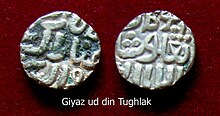Ghiyas-ud-din Tughluq Shah I.
Ghiyas-ud-din Tughluq ( Urdu :غیاث الدین تغلق; Hindi : ग़यासुद्दीन तुग़लक़) or Ghiyath-al-din Tughluq was the founder and first ruler of the Turkish-born Tughluq dynasty in the Sultanate of Delhi . His real name was Ghazi Malik (Urdu: غازی ملِک, Hindi: ग़ाज़ी मलिक). He ruled from 1320 to 1325 and founded the new capital Tughlaqabad , the third of a total of seven or eight historical cities in the area of today's Delhi .
biography
Ghiyas-ud-din was the son of a Turkish slave who had served at the court of Balbans (ruled 1266–1286) and an Indian woman from the Jat community . In 1320 he rose against the last Khilji-Sultan Khusrau Khan (Nasir ud-din Chusrau), who shortly before had murdered the previous Sultan Qutb-ud-din Mubarak Shah . After coming to power, he proved himself a capable ruler - he fought corruption , lowered taxes, and promoted agriculture. In several campaigns he had to deal with Mongolian army units. Victorious campaigns against Bengal and Warangal strengthened the power of the Sultanate. Ghiyas-ud-din died in 1325 of complications from heat stroke ; he installed his son Muhammad bin Tughluq as his successor .
mausoleum

The mausoleum for Ghiyas-ud-din is located over 200 meters from the ruins of the Tughlaqabad fortress on a former small island fortress and was only accessible via a 26-arch bridge before the lake was drained. Due to the delicacy of its stone work, it differs considerably from the other - also beveled - fortress walls. The tomb, which was built on a square ground plan with a side length of around 18.75 m, tapers conspicuously towards the top; inside the building measures only 11.75 m. The approximately 24.40 m high external building is largely clad with slabs of red sandstone, in which stripes, arches or fields of white marble are inlaid, especially in the upper area. Due to the sloping and decor-free architecture, the building looks almost like a fortress, to which the surrounding battlement contributes a certain part. The single-shell dome, clad with slabs of white marble, closes with a ring-shaped amalaka stone, borrowed from Hindu architecture , on which a vase ( kalasha ) sits. The grave building is accessible through entrance portals on three sides; The inner west wall, on the other hand, contains a portal-like mihrab niche made of white marble instead of a portal . Inside there are three cenotaphs - next to the one for Ghiyas-ud-din in the middle one for his wife and one for his son and successor Muhammad bin Tughluq († 1351).
literature
- Hermann Kulke , Dietmar Rothermund : History of India. From the Indus culture to today. CH Beck, Munich 2010, ISBN 978-3-406-60414-0 .
Web links
- Mausoleum of Ghiyas-ud-din-Tughluq - Photo + Info (Archnet, Engl.)
| predecessor | Office | successor |
|---|---|---|
|
Nasir ud-din Chusrau ( Khilji Dynasty ) |
Sultan of Delhi ( Tughluq Dynasty ) 1320-1325 |
Muhammad bin Tughluq |
| personal data | |
|---|---|
| SURNAME | Ghiyas-ud-din Tughluq Shah I. |
| ALTERNATIVE NAMES | Ghiyath-al-din Tughluq; Ghazi Malik Tughluq |
| BRIEF DESCRIPTION | Founder and first ruler of the Turkish Tughlak dynasty in the Sultanate of Delhi |
| DATE OF BIRTH | 13th Century |
| DATE OF DEATH | 1325 |




